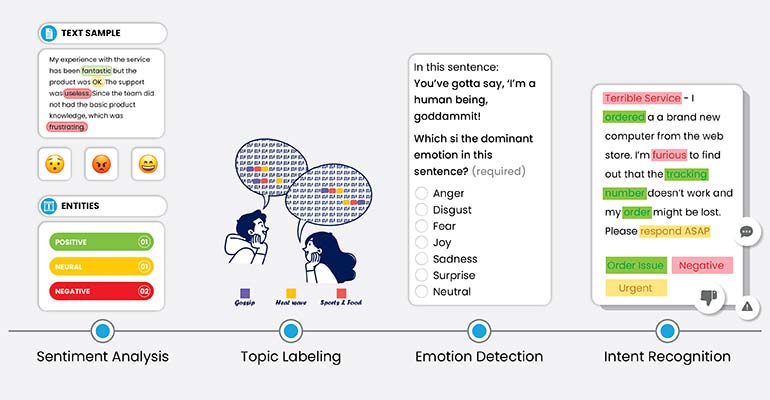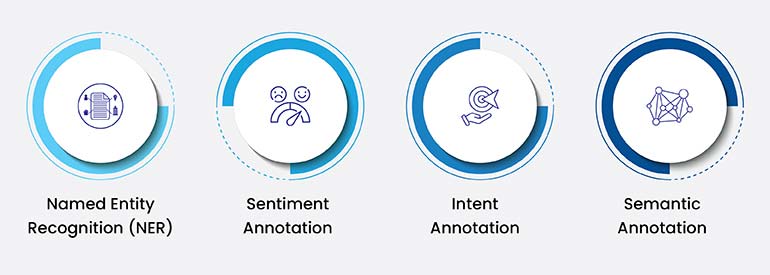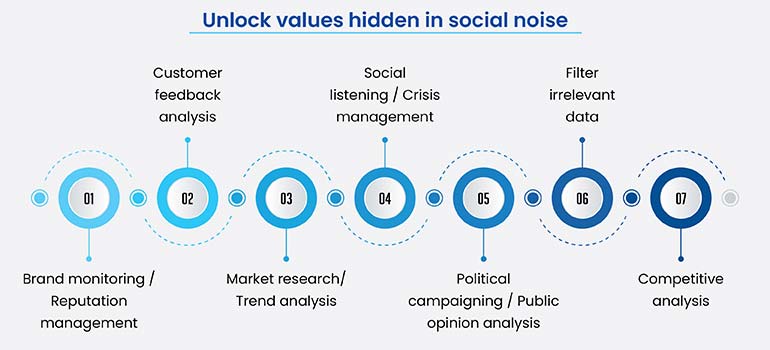10 Powerful eCommerce Data Collection Strategies & Examples
Text annotation is crucial for analyzing social noise on social media, the unnecessary information on social media. It helps businesses understand customer sentiment and respond to trends. Combining automated tools with human expertise helps you to effectively analyze social noise and maintain a competitive edge.
Table of Contents
Leveraging text annotations to understand and analyze social noise has become increasingly vital. With over 5 billion active social media users worldwide, the volume of online conversations is staggering, making it essential for businesses to navigate this complex environment effectively.
Social noise refers to extraneous information and emotional influences that can distort or obscure the intended message within online interactions. This phenomenon complicates how brands perceive consumer sentiment, as 80% of tweets about customer service are negative. This highlights the urgent need for effective text annotation, culminating in social media monitoring strategies.
Furthermore, 61% of businesses now employ social listening techniques to glean actionable insights from these conversations. With scalable text labeling solutions for analyzing social noise, companies now better understand customer behavior and respond proactively to emerging trends and sentiments. As the digital world continues to evolve, mastering social noise analysis is key to maintaining a competitive edge in the marketplace.
Text annotation plays a pivotal role in social noise analysis by providing structured insights from unstructured data. Various annotation techniques are essential for understanding the nuances of online conversations.

Text annotation employs both manual and automated methods. Manual annotation relies on human annotators who interpret and label data, ensuring high accuracy but requiring significant time investment. Automated tools like Amazon SageMaker and Scale AI streamline this process, significantly reducing time and effort.
Other popular tools include Doccano, an open-source platform for text classification, and Prodigy, which enhances manual annotation efficiency through active learning techniques. Automated methods utilize machine-learning algorithms to label data quickly, although they may struggle with nuanced texts.
However, it would be unfair not to mention human annotated training datasets by data annotation service providers. Despite the rise of AI-assisted annotation tools, human expertise remains invaluable. A human-in-the-loop approach ensures that nuanced interpretations are captured accurately. Research indicates that diverse teams can enhance model performance by up to 20%, highlighting the importance of varied perspectives.
Struggling with the complexities of annotating social media text for accurate noise analysis?
Text annotation faces significant challenges in the context of social noise analysis, particularly due to the complexities of the language used on social media platforms.
Handling sarcasm and ambiguity: Sarcasm and ambiguous language complicate sentiment interpretation for both human annotators and machine learning models. Studies indicate that nearly 30% of social media posts contain sarcasm, making accurate detection crucial for understanding true sentiment.
Ambiguous language complicates sentiment interpretation for both human annotators and machine-learning models. Studies indicate that sarcasm can reduce sentiment analysis accuracy by up to 50%. For example, a statement like “Great job on the presentation!” may be sarcastic, depending on context, making it difficult to ascertain true sentiment.
Scalability issues with large datasets: The sheer volume of social media data presents scalability challenges. With over 500 million tweets sent daily, manual annotation is impractical and time-consuming. Estimates suggest it can take up to 40 hours to annotate just 1,000 tweets. Automated tools are essential, but they must maintain accuracy to be effective.
Annotating social noise data: Social media language is often informal, filled with slang, abbreviations, and evolving trends add layers of complexity to annotation tasks. The use of trendy abbreviations and emojis can obscure meaning, requiring advanced techniques for accurate interpretation. For instance, terms like “lit” or “salty” can change meaning rapidly. This dynamic nature requires constant updates to annotation guidelines and tools.
Unstructured nature of social media data: This further complicates the extraction of meaningful insights. Approximately 80% of social media data is unstructured, highlighting the necessity of a flawless text annotation process to effectively decode this information.
As users increasingly engage in diverse forms of communication, including emojis and hashtags, the need for robust annotation techniques becomes critical for accurately capturing sentiment and intent in social noise analysis. Addressing these challenges is vital for businesses seeking to leverage social noise analysis to improve customer engagement and brand management.
Text annotation enables businesses to extract valuable insights from vast amounts of unstructured data. Various types of text annotation play a significant role in this process.
Four key text annotations techniques used for social noise analysis.

Together, these annotation types empower businesses to navigate the complexities of social media interactions and respond proactively to consumer sentiments and trends.
Text annotation empowers companies to sift through the vast sea of social media data and extract valuable insights. By tagging text with labels like sentiment, topic, or intent, businesses can filter out irrelevant noise and focus on meaningful conversations. This enables them to understand customer opinions, track brand perception, identify emerging trends, and respond effectively to online crises.
Here’s how text annotation unlocks the true value hidden within social noise:

Text annotation not only filters out irrelevant chatter but also focuses on actionable insights, empowering companies to navigate the complexities of social noise.
Effective text annotation is essential for maximizing the value of social noise analysis. Implementing text annotation best practices can significantly enhance the quality and reliability of annotated data.
Adhering to these best practices not only improves the quality of text annotations but also ensures that businesses can derive actionable insights from social noise analysis effectively. By investing in clear guidelines, suitable tools, and a skilled team, organizations can navigate the complexities of social media data with confidence.
The future of text annotation in social noise analysis is poised for significant advancements driven by the increasing sophistication of AI and machine learning techniques.
Text annotation is a critical component of effective social noise analysis. By embracing AI-assisted annotation, advanced analytics, and ethical considerations, organizations can harness the power of social data to gain valuable insights and make informed decisions.
Text annotation plays a critical role in understanding public sentiment, tracking brand reputation, and analyzing customer feedback. As technology advances and social media continue to evolve, the role of text annotation will only grow in significance. As organizations adapt to these changes, they can harness the full potential of social data while maintaining ethical standards and consumer trust. By combining automated tools with human expertise, organizations can navigate the complexities of social noise analysis effectively and responsibly.
What’s next? Message us a brief description of your project.
Our experts will review and get back to you within one business day with free consultation for successful implementation.
Disclaimer:
HitechDigital Solutions LLP and Hitech BPO will never ask for money or commission to offer jobs or projects. In the event you are contacted by any person with job offer in our companies, please reach out to us at info@hitechbpo.com
Leave a Reply